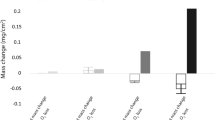Abstract
The Na2SO4-induced accelerated oxidation of nickel has been studied at 1000°C. It has been found that low oxygen activities in the Na2SO4, which are produced by the formation of NiO, cause the sulfur activity of the Na2SO4 to be increased. Nickel and sulfur from the Na2SO4 combine to form nickel sulfide and the oxide ion activity of the Na2SO4 is increased. The accelerated oxidation of nickel occurs because oxide ions react with NiO to form a nonprotective oxide scale. The accelerated oxidation of nickel is not self-sustaining since oxide ions are not produced when conditions in the Na2SO4 are no longer favorable for the formation of nickel sulfide.
Similar content being viewed by others
References
A. U. Seybolt and A. Beltran: Am. Soc. Testing Mater., Spec. Tech. Publ. No. 421, pp. 21–36, 1967.
A. U. Seybolt:Trans. TMS-AIME, 1968, vol. 242, pp. 1955–61.
N. A. Bornstein and M. A. DeCrescenti:Trans. TMS-AIME, 1969, vol. 245, pp. 1947–52.
J. F. Elliot and M. Gleiser:Thermochemistry for Steelmaking, vol. l, pp. 190, 201, 253, Addison Wesley Co., Reading, Mass., 1960.
F. D.Richardson and J. H. E. Jeffes:J. Iron Steel Inst., 1952, vol. 171, p. 167.
W. J. Cooper and D. A. Scarpiello: Thermodynamic Properties of Metal Bromides, Iodides, Sulfides, Sulfates, Chromate, Metaphosphates, Orthophosphates, Molybdates, Tungstates, Borates and Hydroxides, Final Report SC-RR-64-67 (Jan. 1964), Callery Chemical Co. to Sandra Corp.
T. Rosenqvist:J. Iron Steel Inst., 1954, vol. 176, pp. 37–57.
H. Braune, S. Peter, and V. Neveling:Z. Naturforsch., 1951, vol. 6a, pp. 32–37.
W. M. Vogel:Electrochem. Acta, 1968, vol. 13, pp. 1815–20.
J. G. Tschinkel: Pratt & Whitney Aircraft, Advanced Materials Research and Development Laboratory Memo No. J.G.T.-l, July 1966, Middletown, Conn.
M. A. DeCrescenti and N. S. Bornstein:Corrosion, 1968, vol. 24, pp. 127–33.
F. S. Pettit, J. A. Goebel, and G. W. Goward:Corrosion Sci., 1969, vol. 9, pp. 903–13.
E. L. Simons, G. V. Browning, and H. A. Liebhafskey:Corrosion, 1955, vol. 11, pp. 505t-14t.
J. M. Quets and W. H. Dresher:J. Mater., 1969, vol. 4, pp. 583–99.
M. A. DeCrescenti and N. Bornstein: Investigation of Sulfidation Mechanism in Nickel Base Superalloys. Final Report, conducted for the U. S. Naval Ship Research and Development Laboratory, Contract No. NOO 600-68-C-0639, April 1969, Annapolis, Md.
F. S. Pettit:Trans. TMS-AIME, 1967, vol. 239, pp. 1296–1305.
Author information
Authors and Affiliations
Rights and permissions
About this article
Cite this article
Goebel, J.A., Pettit, F.S. Na2SO4-induced accelerated oxidation (hot corrosion) of nickel. Metall Trans 1, 1943–1954 (1970). https://doi.org/10.1007/BF02642794
Received:
Issue Date:
DOI: https://doi.org/10.1007/BF02642794




